Wondering how to become fluent in a language? We can't blame you! If you're like most language learners, the idea of effortlessly speaking a new tongue is an intoxicating fantasy. But let's be real - between work, family, and Netflix binges, finding time for traditional classes feels next to impossible.
That's where these 7 viral language apps come in. They're the real deal-pocket linguists that adapt to your busy lifestyle with bite-sized lessons you can smash anytime, anywhere. From your morning commute to those endless conference call lulls, these apps turn your dead time into actual fun lessons.
And the best part? Most of these tongue-untying gems offer FREE trials to start. That means you can test the functionalities first before making a commitment.
Want to know which language tools made the cut and how to get the most out of them with a free step-by-step cheat sheet? Keep reading for the full lowdown on why these 7 language learning apps have students everywhere going viral with their new language skills!
Do Language Learning Apps Work?
Yes, language learning apps are effective for improving grammar, vocabulary, and speaking skills. In fact, latest research from Michigan State University shows that while most users enhance their grammar and vocabulary, almost 60% also improve their oral proficiency. Additionally, multiple studies have found that using some of the best language learning apps for as little as 4-34 hours can produce language gains equivalent to a university semester of classroom learning.
However, apps alone can't make you fluent. True fluency requires immersion and interaction with native speakers, which apps can't fully provide. For best results, combine app usage with methods like high-frequency phrases, comprehensible input, and spaced repetition. Regular use of apps will boost your understanding of a language's lexicon and syntax, but achieving fluency demands more comprehensive, immersive learning experiences.

7 Best Language Learning Apps Trending Online
Language learning apps have exploded in popularity, but not all are created equal. After extensive research and testing by our team of polyglots and language experts, we've narrowed it down to the 7 best apps that truly deliver results for learners of all levels.
Our criteria for selection included effectiveness of learning methodology, quality of lesson content, user experience, review ratings, and affordability. The standout apps on this list leverage techniques like spaced repetition, comprehensible input, gamification, and speech recognition to maximize vocabulary acquisition, grammar understanding, and speaking practice.
Whether you're an absolute beginner or working your plan out on how to become a polyglot, these top-rated apps will supplement your language journey with engaging, interactive, and personalized lessons on the go.
Duolingo

Rating: 🧡🧡🧡🧡
Best For: Gamified vocabulary building and beginner language basics
During our 100-day trial using Duolingo daily, we experienced firsthand why it's one of the most popular language learning apps. Duolingo's biggest strengths are its addictive game-like lessons, simple but polished user interface, and bite-sized format that makes daily practice easy to habit-stack.
The app gamifies the learning process through point scoring, level progressions, and rewarding streaks. This nudges you to keep practicing with delightful dopamine hits. The lessons themselves are short, snappy, and cover reading, listening, speaking, and writing through a mix of translation exercises, speaking practice, and quick comprehension tests.
While hugely effective for vocabulary building and getting beginners comfortable with a new language, more advanced learners may find Duolingo too simplistic and too reliant on decontextualized sentences. There's also a lack of detailed feedback on pronunciation and speaking skills.
However, if you're just getting started or want to revive rusty language skills through low-stakes microlearning, Duolingo is an addictive, fun, and frictionless option to build a consistent daily habit. We found the gamified style truly did "make the lessons stick" during our 100-day trial.
Lingopie
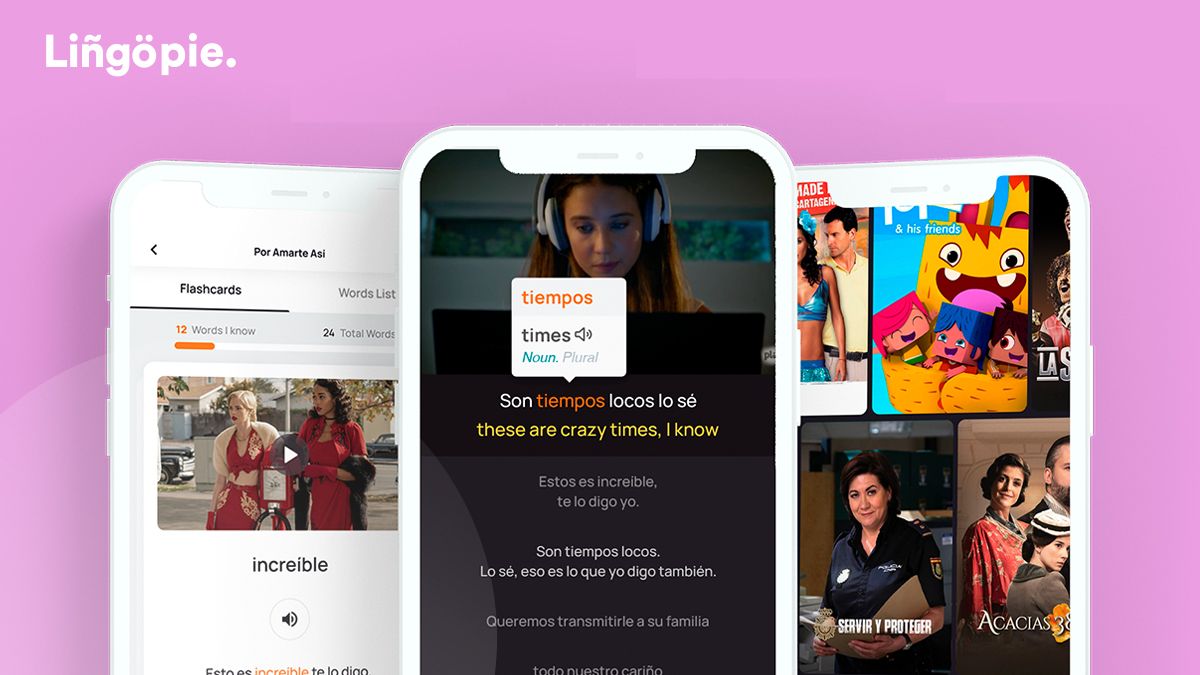
Rating: 🧡🧡🧡🧡🧡
Best For: Immersive learning through entertaining foreign movies and shows
Lingopie is one of the most engaging and effective apps for contextual language learning through entertainment immersion. Its core binge-watching methodology involves watching foreign films and shows with dual subtitles that display both the original and your native language line-by-line. This mirrors the natural way babies acquire language through context.
Beyond just dry vocabulary drills, you start absorbing how grammar, slang, idioms, and conversational structure weave together organically. The fun, story-driven movie content also conveys cultural context missing from traditional apps.
As you watch, you can toggle between subtitles to test comprehension, bookmark difficult clips, review vocabulary from those scenes, and more. LingoPie's learning tools maximize retention.
While not ideal for total beginners, Lingopie provides intermediate/advanced learners the immersive contextual step needed to transition from textbook concepts to real-world fluency. The multimedia approach keeps you motivated long-term.
If you've plateaued on vocabulary apps and crave authentic immersion, LingoPie's unique learn-through-entertainment model could be the ideal supplement for finally mastering conversational abilities.
Beelingua

Rating: 🧡🧡🧡
Best For: Reading and listening immersion for intermediate/advanced levels
After our 100-day trial using both the free and paid features of Beelingua, we discovered a unique language app perfectly suited for intermediate to advanced learners wanting to boost their skills through reading and listening immersion. So if you're literally trying to learn from scratch, we highly recommend starting with other apps.
Beelingua's core strength is its library of reading materials like news articles, books, lyrics, and more - available in a bilingual side-by-side format with customizable options to showcase one or both languages. Having the native and learned language in parallel provides a crucial context for natural language acquisition.
We found the reading experience engaging as you can tap unknown words for definitions, playback audio for sections, and review challenging phrases. The app's speech recognition also allows you to read passages aloud and get feedback.
However, Beelingua isn't ideal for absolute beginners since it relies heavily on existing vocabulary knowledge. Some may also find the synthetic voices robotic compared to human audio. And while the content selection is diverse, it could be expanded further.
Drops
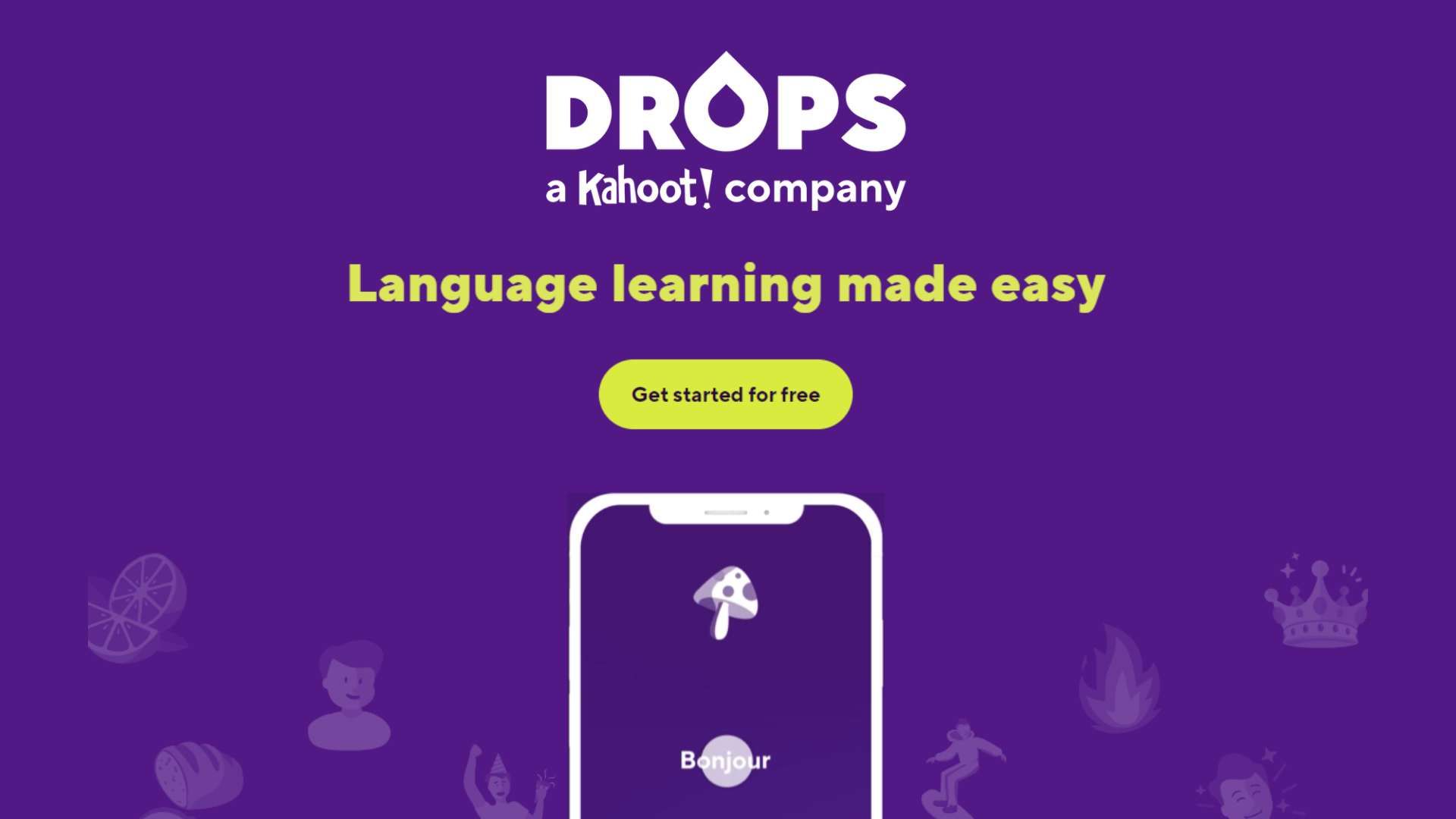
Rating: 🧡🧡
Best For: Visual vocabulary acquisition through illustrations and word associations
Drops proved to be an excellent app for visually building vocabulary through bite-sized daily reps and gamified learning. It's biggest strength is making vocab acquisition feel like an addictive matchy-matchy mobile game. It pairs words with vivid illustrations and audio clips, challenging you to make pattern-matching associations.
In terms of UI/UX, the clean, minimalist design is perfect for beginners to focus on high-frequency words across practical topics like food, travel, personality traits and more. And you can quickly toggle between learning modes like word-to-word or word-to-image.
However, Drops is very narrowly focused on isolated vocabulary through its flashcard-style format. It doesn't go much into grammar, sentence structure, or other linguistic complexities beyond standalone words. The relevance and translations of some words can also be hit-or-miss.
But if your goal is simply building a foundational vocabulary through short, daily micro-lessons, Drops gamifies and visualizes the process splendidly. We found the app perfect for supplementing phrasebook-style rote memorization during our trial.
Falou
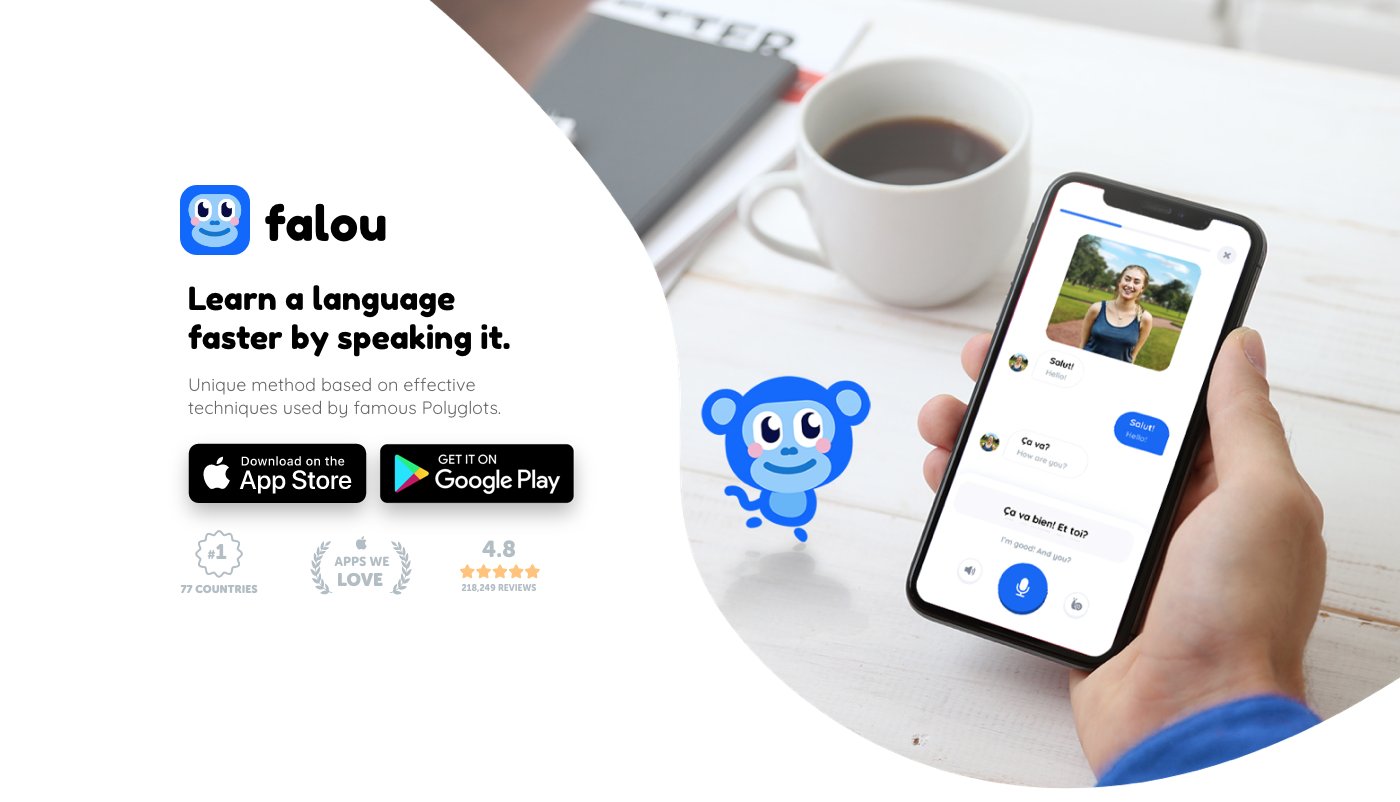
Rating: 🧡🧡🧡
Best For: Conversational practice with speech recognition for pronunciation
With Falou, you can learn to speak up to 25 languages by practicing with native speakers from all around the world. In short, this is one of the best language-learning apps for working on real-life conversation skills. We also noticed that the lessons also progress naturally from essential phrases to complex back-and-forth discussions across practical scenarios like shopping, traveling, and more, making it really great for beginners.
The app's strengths include its fun, gamified approach using animated characters and speech recognition to make conversations interactive. You can record yourself and get feedback on pronunciation. The clean visual layout with images, text and audio also caters well to visual learners.
While comprehensive for speaking practice, some may find Falou lacking in depth for other skills like reading, writing, and advanced grammar. There are also occasional bugs or quirks in the speech recognition reported.
However, if your primary goal is confidently holding conversations as a beginner or intermediate learner, few apps make the process as engaging and addictive as Falou's simulations. The graduated lessons did build our fluency substantially during the 100-day trial period.
Tandem
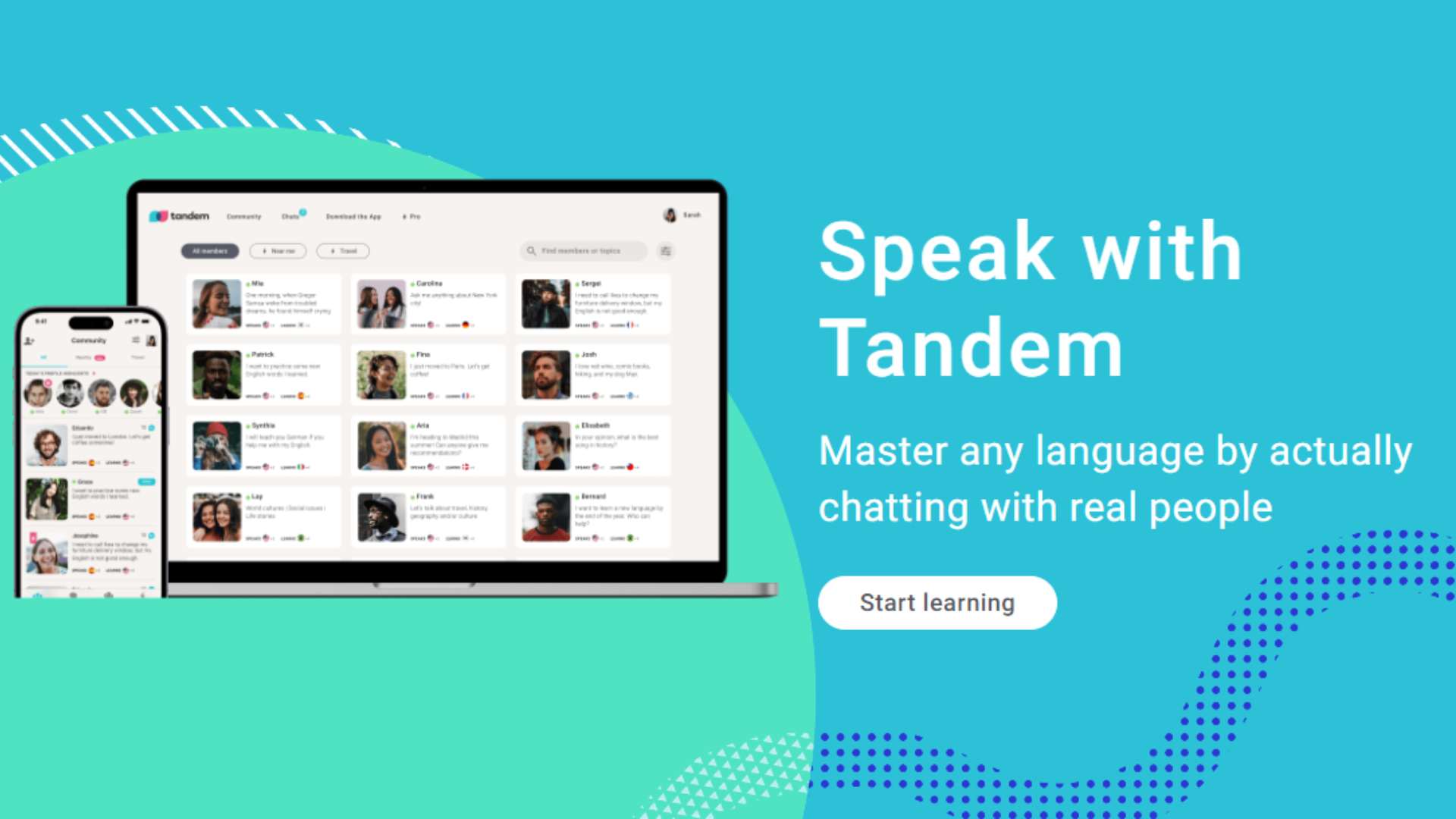
Rating: 🧡🧡🧡
Best For: Virtual language exchanges to practice casual conversations
During our 100-day experience with Tandem, we found it to be a uniquely social and practical way for intermediate learners to advance their conversation skills through virtual language exchanges.
Unlike most tutoring apps, Tandem connects you directly with native speakers interested in reciprocal learning. The well-designed interface lets you find partners based on interests, goals, and languages - facilitating an easy back-and-forth flow of informal practice.
In-app tools like translation, voice recording, and corrections allow you to get feedback seamlessly within your chats. We found this immersive approach incredibly useful for picking up nuances, slang, and natural speaking patterns that textbook lessons often miss.
However, Tandem requires commitment from both partners to make the most of the experience. Conversation quality can vary, and some may find the social approach intimidating compared to structured lessons. The app also isn't well-suited for absolute beginners.
But for intermediate learners craving real-world practice, few options beat Tandem's ability to have low-pressure yet immersive verbal exchanges tailored to your needs. The 100 days using it noticeably improved our confidence in casual conversations.
Babbel
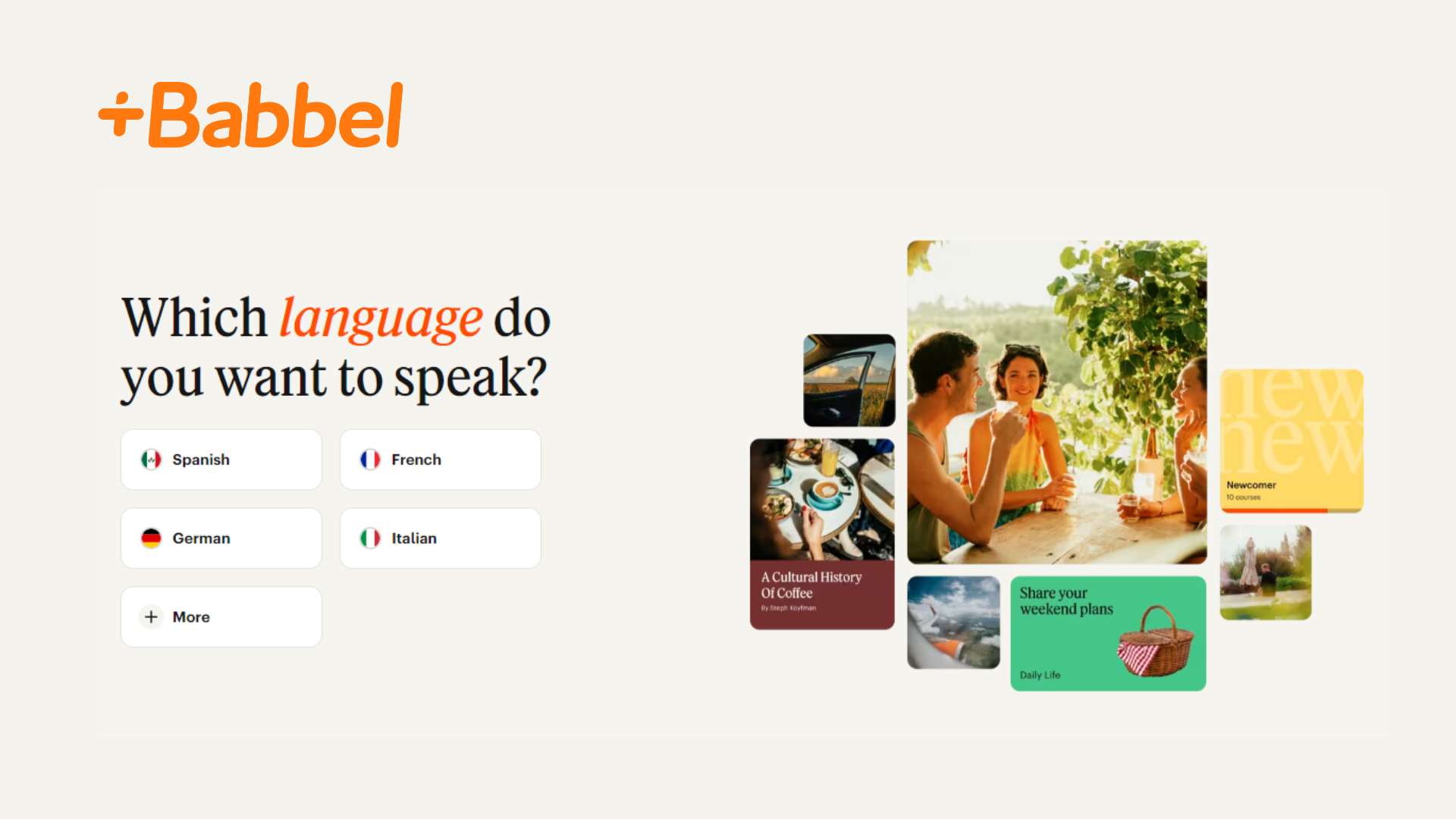
Rating: 🧡🧡🧡🧡
Best For: Comprehensive, structured lessons across all skills for new languages
Over a 100-day trial period using Babbel daily, we found it to be one of the most comprehensive and methodical apps for building a solid foundation in a new language from the ground up.
Babbel's strengths lie in its curriculum-based progression system that gradually layers reading, writing, listening, and speaking exercises across practical real-world topics. The bite-sized lessons feel akin to classroom instruction, systematically covering vocabulary, grammar, pronunciation and more.
While some apps focus narrowly on vocabulary or conversational basics, Babbel takes a blended approach that emphasizes understanding the full linguistics and contextual cultural nuances. We appreciated how it balanced repetitive drills with fresh content to reinforce concepts.
The clean, minimalist design keeps you focused, though the lack of gamification or immersive multimedia may make the lessons feel dry for some. Speech recognition for pronunciation isn't always accurate either.
However, if you're looking for a structured, almost academic-like experience for acquiring beginner to intermediate proficiency from scratch, few apps guide you as comprehensively as Babbel's evolving curriculum. The 100-day investment paid off with tangible progress.
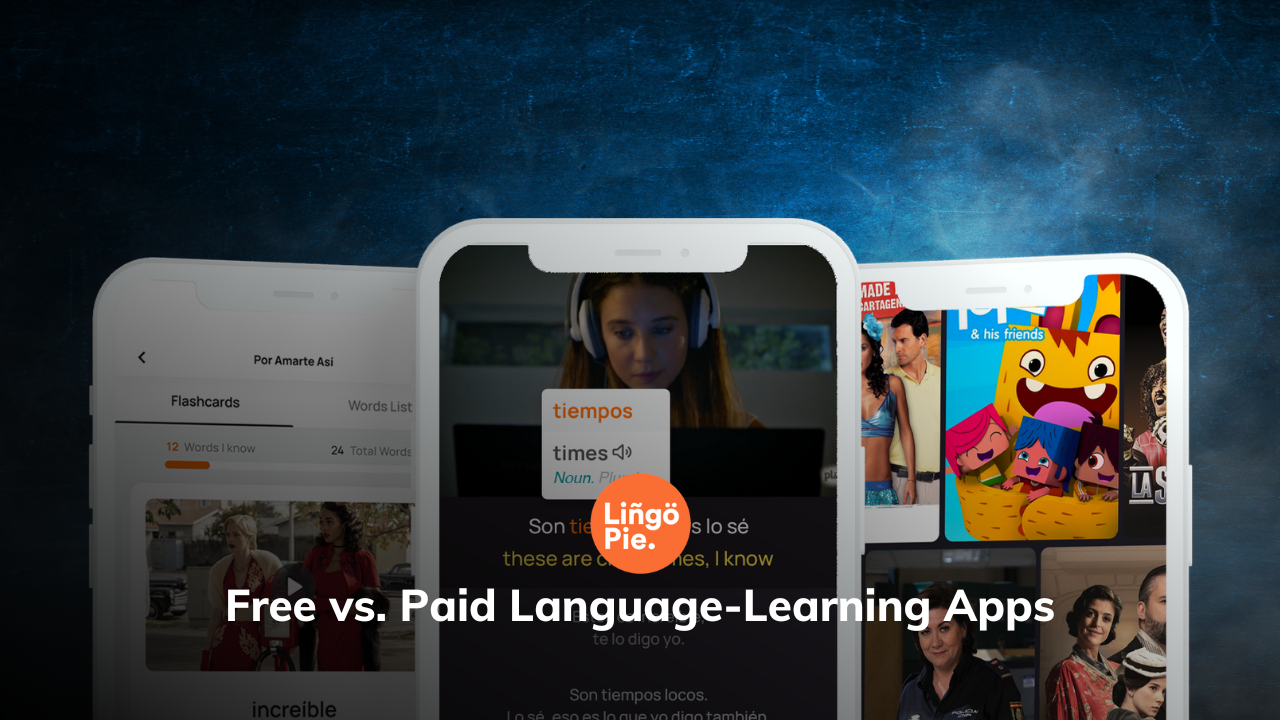
Other Language Learning Apps Worth Considering
Speakly
Speakly focuses on speaking, listening, reading, and writing practice. The languages offered are currently Russian, Estonian, Finnish, English, French, Spanish, German and Italian.
This app uses a Spaced Repetition System to help you move new vocabulary into your long-term memory. Speakly teaches you the 4000 most useful and statistically relevant words in your target language.
You can start by stating your language level and taking a test to see how many of the 4000 words you already know. Then, set a goal for how many new words you would like to learn each day.
Speakly was created and researched by language experts from 4 countries over a span of 5 years. The two co-founders of Speakly are polyglots who speak 7 languages each! Combined, they have more than 20 years of experience teaching, translating, and researching innovative language-learning methodologies.
Promova
This language learning app creates an engaging step-by-step plan for your language development. This makes language learning accessible, structured, and even fun.
Focusing on all aspects of learning languages, Promova has activities for speaking, reading, writing, and listening. What's more, there is a diverse community of learners who use this app. Connect with fellow learners and discuss ideas, find a language exchange partner, and make like-minded friends.
Promova offers interactive exercises and active opportunities for learning. You can practice your pronunciation with the app's speech recognition technology and have real conversations in one-on-one sessions with a tutor.
There are video clips for visual learners that teach grammar lessons, pronunciation, and vocabulary acquisition. This app offers diverse interactive exercises that suit all different kinds of learners.
Ling
Ling is a game-oriented language app that offers learning content in 60 different languages. You can match words with images, record yourself speaking, play short games, and use interactive flashcards on Ling.
This is not the most comprehensive learning app for the more popular languages, but it does make an excellent starting point for some of the more niche languages that might not be offered on the other language learning apps.
Ling provides fun, engaging, and sometimes silly language practice activities that have similar visuals to Duolingo. The app offers extensive grammar tips, daily life topics to practice, and hundreds of dialogues.
SpanishDict
This is the world's most popular web app for Spanish language reference and study materials. SpanishDict is used by millions of learners annually and provides millions of free dictionary translations, as well as conjugation of every Spanish verb.
SpanishDict also uses clever technology to compare online translation engines to provide users with the most accurate and helpful translation. When you search for a word or phrase, SpanishDict pulls up several examples of its usage so you can see it in context.
This is not like other apps, as it goes beyond offering engaging lessons. SpanishDict is a comprehensive dictionary and one of the best mobile apps for vocabulary-building and translation purposes.
Kleo
This app focuses heavily on speaking and developing your natural conversation skills. Through intensive verbal practice, you will learn to use your target language just like its native speakers.
Imagine if a personal tutor and a language app had a baby. Kleo combines the best aspects of in-person teaching with the convenience of a mobile app.
Kleo uses AI speech recognition exercises to evaluate your pronunciation and provide instant feedback. Your speech is compared with recordings of native speakers to help you to perfect your fluency.
You can subscribe for 1 week, 1 month, 3 months, or 6 months with Kleo. During this time, you will work on correct pronunciation, learn vocabulary relevant to real-life situations, and become well-acquainted with basic words in a second language.
Rosetta Stone
The Rosetta Stone app is another language learning platform that employs traditional learning styles to teach over 25 languages. You can download materials and take them on the go, so you don't even need an internet connection to learn.
Rosetta Stone teaches reading, writing, listening, and speaking in short, palatable lessons that teach you about the culture of a country while you learn the language. If you like the idea of learning offline, try this app for a subscription fee.
How To Use Language Learning Apps Properly
While language apps offer incredible convenience, simply installing them doesn't guarantee fluency. To ensure you're efficiently extracting all an app has to offer, follow these tips:
Set Specific SMART Goals
Don't just think "learn Spanish." Set concrete SMART goals like "Converse comfortably about travel after 6 months" or "Read/comprehend novels within a year." This focuses your approach.
Schedule It Like Meetings
Treat app sessions as important calendar appointments. Schedule 15-30 minute windows daily (during commutes, lunch breaks, etc.) and set reminders to cement the routine habit.
Mix It Up - Use Resources Intelligently
Alternate between vocabulary (Drops), conversations (Tandem), grammar (Babbel), immersion (LingoPie) etc. to cover all bases. The variety keeps you engaged.
Apply It Or Lose It
Follow up lessons by writing sample sentences, narrating your day, or conversing with a language partner. You'll reinforce weak areas through active reps.
Track Via Habit Apps
Download habit tracking apps (Streaks, Way of Life) and log your daily study, streak scores, milestones, etc. Gamifying your progress keeps you motivated.
Immerse Your Interests
Stream foreign shows, movies; listen to music; read books/blogs on hobbies you enjoy. Engaging with interests enhances contextual comprehension.
Test Periodically
Every 6-8 weeks, evaluate your skills via online proficiency tests. Measurable growth indicatorsulla maintain long-term persistence.
Consistency compounds quickly when you follow focused specificity, structured scheduling, multi-modal practice, applied output, meticulous tracking, fully-contextual immersion, and periodic assessments.
FAQs
What Is The Best Language Learning App For Beginners?
Depending on which language skill you wish to work on, there are different apps that might suit you best. However, for access to the authentic language spoken by native speakers, the best language-learning app would be Lingopie.
Moreover, for speaking practice, you can supplement your learning with Falou. On top of these great apps, you can use social media apps, such as TikTok and Instagram to learn foreign languages.
Which Teaching Methods Do Language Apps Use?
Generally, the best apps use a range of teaching methods to impart information to the language learner.
They will incorporate images next to vocabulary for visual learning, employ spaced repetition for memorization, and put language into context in bite-sized lessons to make it accessible and palatable.
The best apps use aspects of traditional learning, such as flashcards and quizzes, alongside modern engaging methods, like binge-watching TV shows or using AI speech recognition.
Can You Become Fluent By Using Language Apps?
You can certainly become proficient with your foreign language speaking skills by using the best apps for language acquisition.
You can learn as many languages as you would like in this manner, but remember to use them in conjunction with other teaching methods, like classes, for the optimum experience.
Just as native speakers learn their native language by listening and repeating new words as babies, so too can you learn a new language by immersing yourself in the language and imitating what you hear.
What Is The Most Effective Language-Learning App?
The most effective language-learning app aligns with your specific reasons for learning the language and how you want to apply those skills. For instance, if your aim is to learn casual, real-life expressions through entertainment immersion, an app like Lingopie that provides dual-subtitled foreign media is ideal. For those prioritizing vocabulary building through gamified reps, apps focused narrowly on isolated words like Drops or Duolingo excel.
The right app caters to your personal interests and learning objectives, rather than a one-size-fits-all solution. Identify your primary goals first, then match those with an app's specialized approach for maximum effectiveness.
What's Better Than Duolingo?
While Duolingo excels at building vocabulary through bite-sized gamified lessons, LingoPie takes a different approach - full immersion through engaging foreign media like movies and shows.
Beyond just isolated words or phrases, you'll start understanding how grammar and syntax weave together in realistic conversations and dialogue. The fun, story-driven content also teaches cultural context and nuance missing from traditional apps. For auditory reinforcement, you can toggle between subtitles to test your comprehension skills. LingoPie's learning tools also allow vocabulary reviews, bookmarking difficult clips, and more.
So if you've plateaued on Duolingo and crave more than just gamified word drills, Lingopie's unique blend of edutainment could be the ideal complement for taking your skills to the next level.
What Is The Most Effective Language Learning Method?
According to Stephen Krashen's Affective Filter Hypothesis, the most effective approach depends on methods that cater to your personal interests and inherent learning preferences. A low "affective filter" - achieved through enjoyable, anxiety-free lessons matching your goals and psychology - accelerates language acquisition.
For example, movie-buffs may thrive using immersive apps like Lingopie, while analytically-minded learners respond best to systematic curricula from apps like Babbel. Conversation-cravers benefit from virtual exchanges on Tandem.
The key is finding engaging methods that tap into your motivations, not something you'll mentally block yourself against due to tedium or incompatibility with your learning tendencies. Effective language learning happens when the affective filter is lowered through personalized, emotionally-aligned approaches.
Is Learning A Language Online Effective?
Studies show that effective online language learning is achievable, but depends greatly on the methods and level of active instruction.
Self-guided apps focused narrowly on vocabulary building like Duolingo or Drops provide a solid foundation, but textbook-style grammar lessons are still beneficial. For well-rounded skills, comprehensive curriculum apps like Babbel or live virtual classes replicate an interactive classroom experience online effectively.
The most impactful online learning, however, comes from multimedia immersion using podcasts, videos, books, etc. Apps like LingoPie deliver this through dual transcripts synced to foreign shows and movies.
Consistent practice over long periods, ideally combining structured lessons with conversations and contextual immersion, produces online learning gains equivalent to classroom courses.
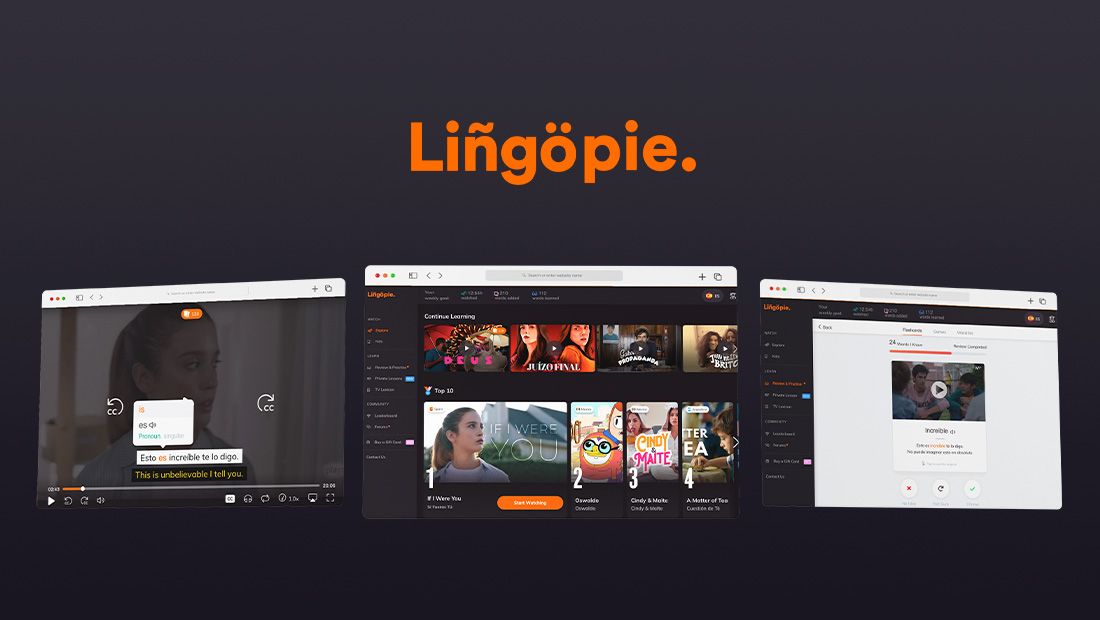
Summing Up: The Best Language Learning Apps
This has been a rundown of the 7 best language learning apps available to language learners today. We have provided details about each app and highlighted what makes them special.
Now, you should have a good idea of which language-learning apps you would like to try. Remember, using several language learning apps in conjunction will maximize your learning potential.
Consider which aspects of language learning you want to work on and choose the best language app to kick-start your learning journey. Unlimited languages and resources are at your fingertips!
Use dictionary apps for vocabulary building, conversation-centered apps for speaking, and streaming services like Lingopie for listening comprehension and fluency.
You will be using your target language like a native speaker in no time!


![7 Best Language Learning Apps In 2024 [+ Free Cheat Sheet]](/blog/content/images/size/w1200/2022/11/The-7-Best-Language-Learning-Apps-for-Foreign-Language-Learning.png)




![Can You Learn Spanish By Watching TV? [15 Easy Tips]](/blog/content/images/size/w300/2024/05/Can-You-Learn-Spanish-By-Watching-TV.jpg)

![6 Easy Ways To Learn A Language With ChatGPT [Guide + FREE Prompts]](/blog/content/images/size/w300/2024/05/Learn-A-Language-With-ChatGPT-.jpg)
